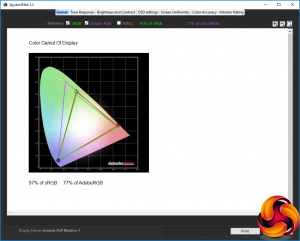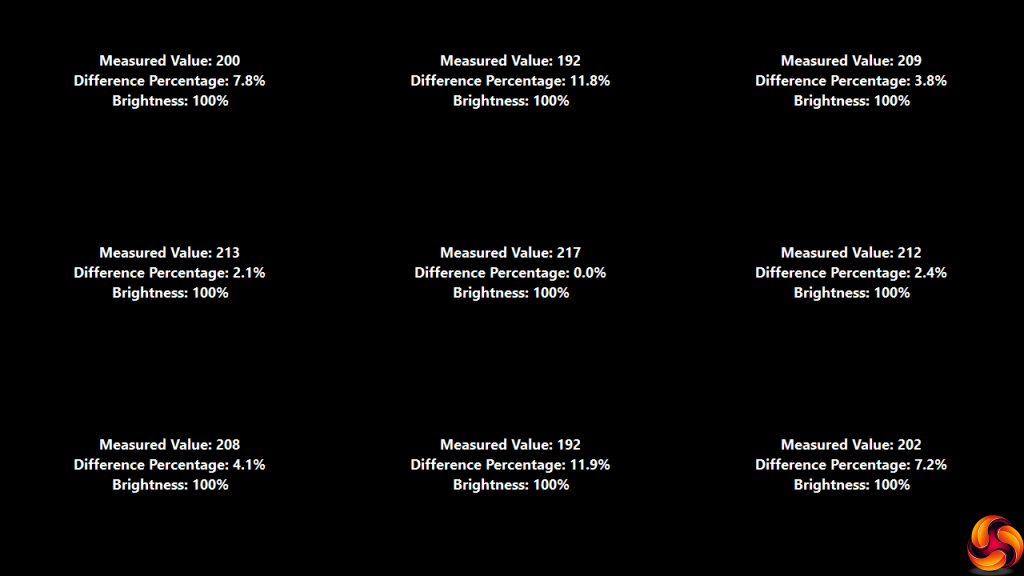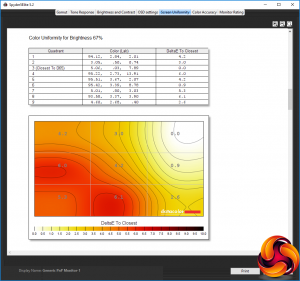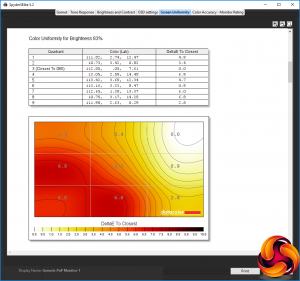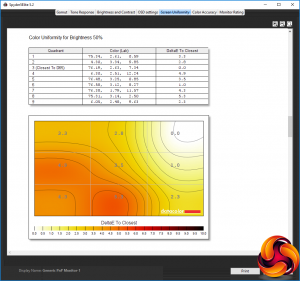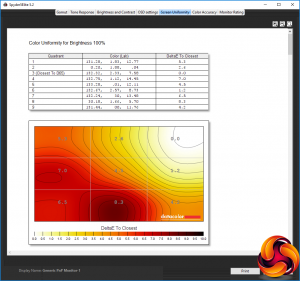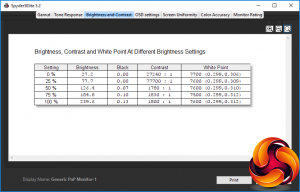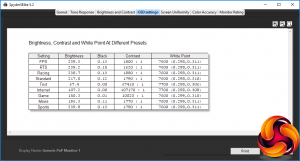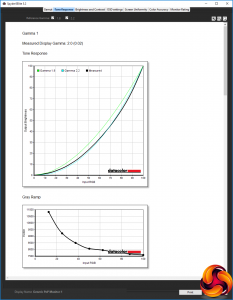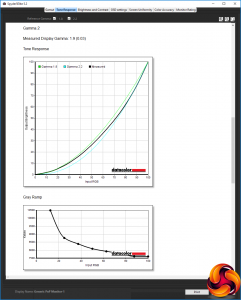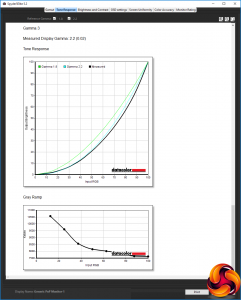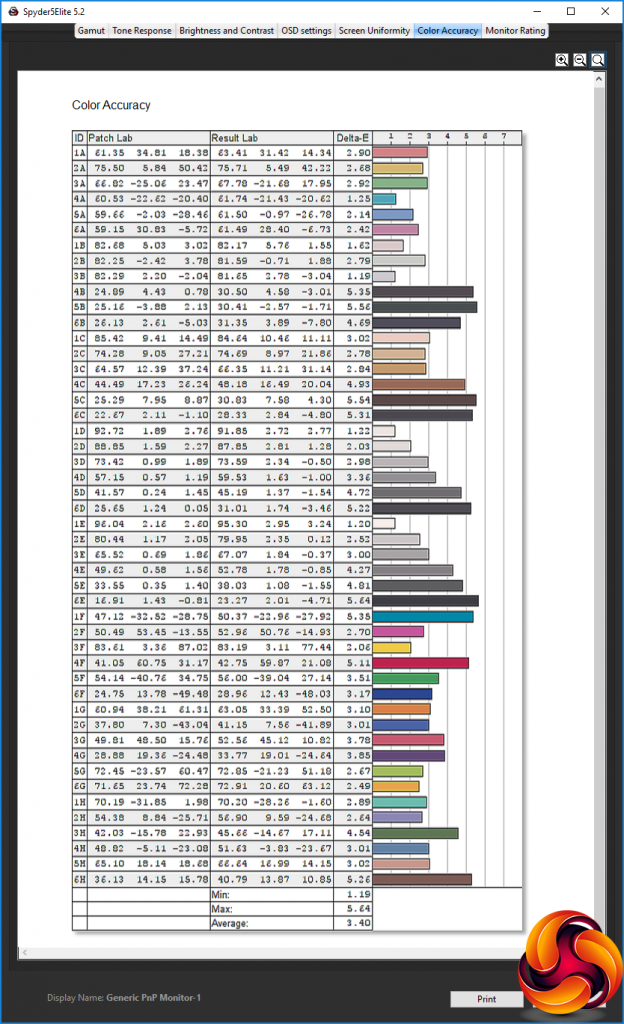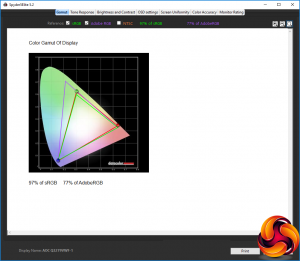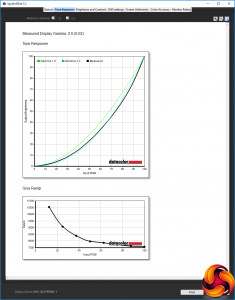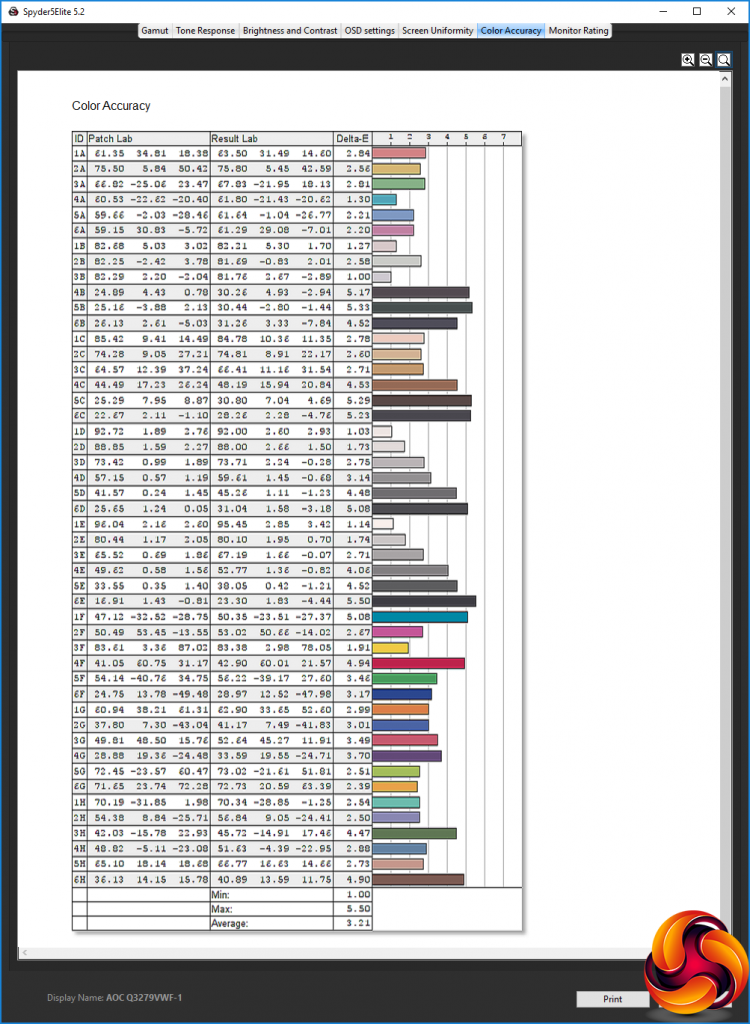Our main test involves using a DataColor Spyder Elite 5 Colorimeter to assess a display’s image quality. The device sits on top of the screen while the software generates colour tones and patterns, which it compares against predetermined values to work out how accurate the screen is.
The results show –
- A monitor’s maximum brightness in candelas or cd/m2 at various levels set in the OSD.
- A monitor’s contrast ratio at various brightness levels in the OSD.
- The brightness deviation across the panel.
- The black and white points
- The colour accuracy, expressed as a Delta E ratio, with a result under 3 being fine for normal use, and under 2 being great for colour-accurate design work.
- The exact gamma levels, with a comparison against preset settings in the OSD.
We first run this test with the display in its default, out-of-the-box state, with all settings on default. We then calibrate the screen using the Spyder software and run the test again.
We always test the display subjectively on the Windows desktop, using it for general tasks such as browsing and word processing, and with games as well, even if the display is not intended solely for that purpose.
We pay careful attention to any artefacts, ghosting or motion blur, and enable any gaming specific features, such as adaptive-sync settings like G-Sync or FreeSync, using a compatible graphics card in our test PC.
In the case of the Q3279VWF, we performed the primary testing at the native 2,560 x 1,440 resolution in the default mode, after resetting the OSD. This also left the screen in AMD FreeSync mode, rather than using a specific set refresh. Our test system was equipped with an AMD Radeon Vega Frontier Edition graphics card, which supports FreeSync.
The gamut is somewhat mediocre, with 97 per cent of sRGB and 77 per cent of AdobeRGB.
Brightness uniformity is not that impressive either, with a number of areas that diverge more than 10 per cent from the centre.
Colour uniformity is similarly problematic, getting worse as the brightness level goes up.
Brightness gets close to the 250cd/m2 specified at 100 per cent setting, although this isn't a very high level compared to most screens. However, the measured contrast stays around the 1,800:1 mark from 50 per cent brightness upwards, which is much more impressive (and the default contrast setting is just 50 per cent). The white point stays around a relatively cool 7500/7600K through most of the brightness range.
The OSD settings results go some way to explaining why the Game modes are separate from the Eco Mode presets. The FPS, RTS and Racing settings are virtually the same in terms of brightness, contrast and white point, all hovering close to 240cd/m2 brightness.
The 7600K white point is identical throughout too. The contrast varies a bit, but not by very much. The Game modes seem to be quick ways to access appropriate pixel response overdrive configurations, with Racing using the highest option since this kind of game is the most lag-sensitive.
The Eco Modes therefore run independently and vary quite a bit. Text goes for low brightness at 67.4cd/m2 but high contrast. Internet ups the brightness a bit to 107.2cd/m2, with even higher contrast, but both use a cool 7700K white point and very low black point. Game mode ups the brightness again to 150.3cd/m2, with a low 0.01 black point and high contrast. Movie is even more bright at 196.3cd/m2, with a higher 0.11 black level and 1,770:1 contrast, whilst Sports is very similar except with 239.8cd/m2 brightness. All the latter three use a 7600K white point.
It's a bit of a surprise that the white point is virtually identical with all presets, and relatively cool. We would have expected different colour profiles to go with the modes, which are essentially just brightness configurations. Usually, an OSD mode aimed at watching movies, for example, will use a different colour temperature to a mode intended to make reading text onscreen more comfortable.
The three Gamma settings are called 1, 2 and 3. The first one equates to 2.0 and the third to 2.2, but the middle mode 2 is actually 1.9, which is very strange and counter-intuitive. We would also have preferred a bit more variation in the gamma levels, as the narrow range makes these gamma modes less useful than they could be.
We have been a bit spoiled of late with top-end screens offering amazing colour accuracy out of the box. Unsurprisingly, this budget screen isn't in that category. The average delta of 3.4 isn't that bad, but this isn't a screen that you would want to use for professional design work – at least, not at default settings. But could calibration improve matters?
As we almost always find, the colour gamut hasn't changed with calibration, remaining at 97 per cent sRGB and 77 per cent AdobeRGB.
We only retested the gamma on the 1 setting, and that didn't change either, staying at 2.0.
Colour accuracy has improved mildly to a 3.21 average delta, which is worth having but still won't make this screen ideal for professional work requiring top fidelity.
We weren't expecting amazing results from this screen given its price, and we didn't receive any surprises during testing. However, whilst its image quality performance and preset configuration aren't great, they're also not terrible, and for someone on a tight budget could well be acceptable.
We also tried some everyday activities and gaming on the screen. Having just switched from the Samsung C32HG70, the inferiority of the AOC Q3279VWF was fairly obvious for gaming, with more perceptible ghosting in fast motion and the screen not keeping up with high frame rate delivery from our system's AMD Radeon Vega Frontier Edition. But with the C32HG70 costing triple the price, this isn't a tremendously fair comparison anyway.
 KitGuru KitGuru.net – Tech News | Hardware News | Hardware Reviews | IOS | Mobile | Gaming | Graphics Cards
KitGuru KitGuru.net – Tech News | Hardware News | Hardware Reviews | IOS | Mobile | Gaming | Graphics Cards




